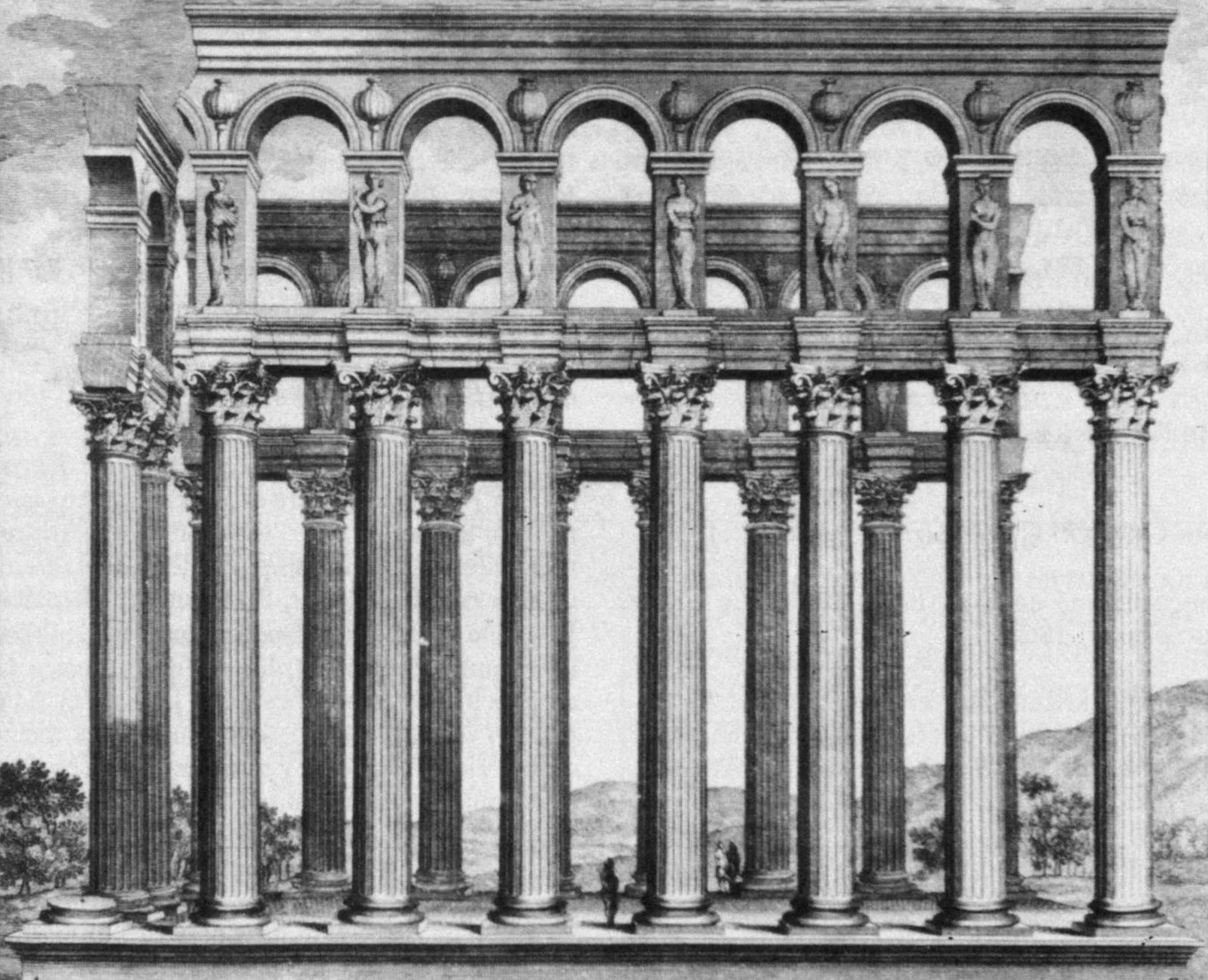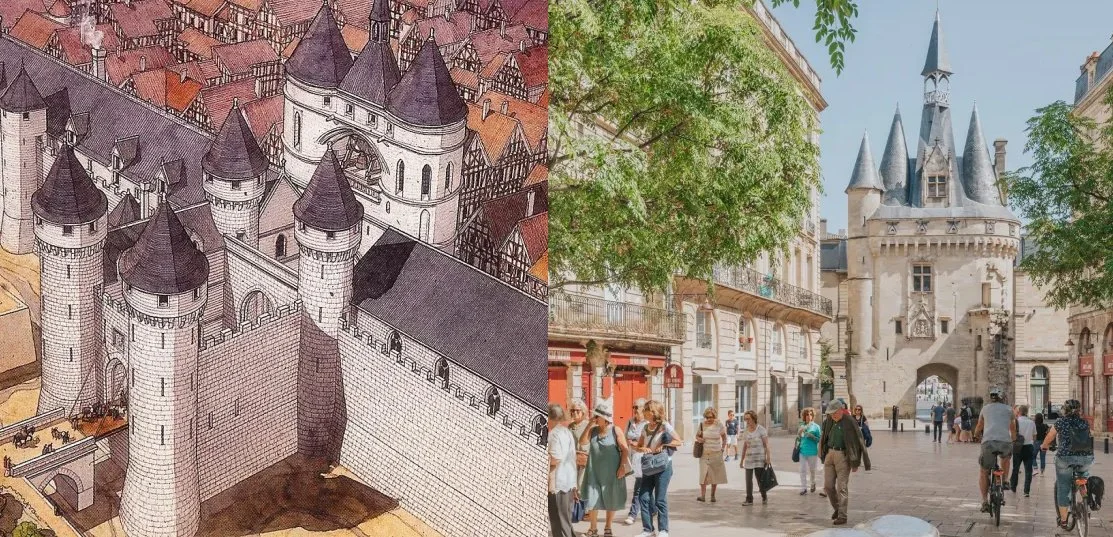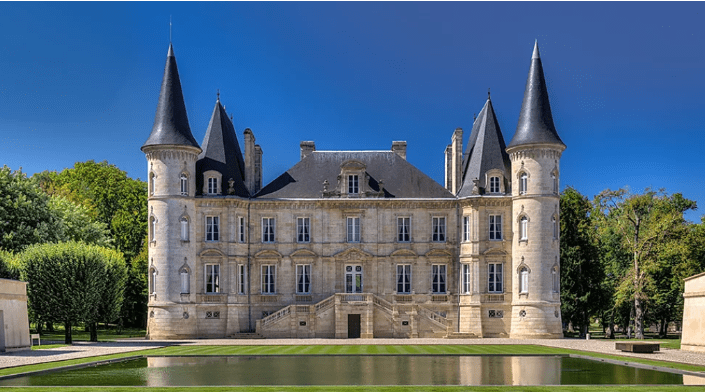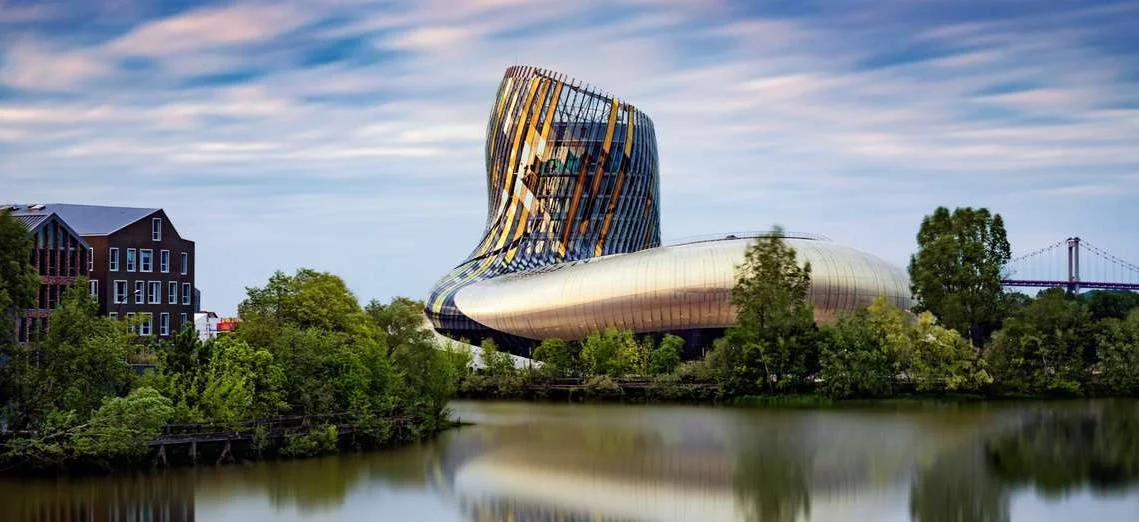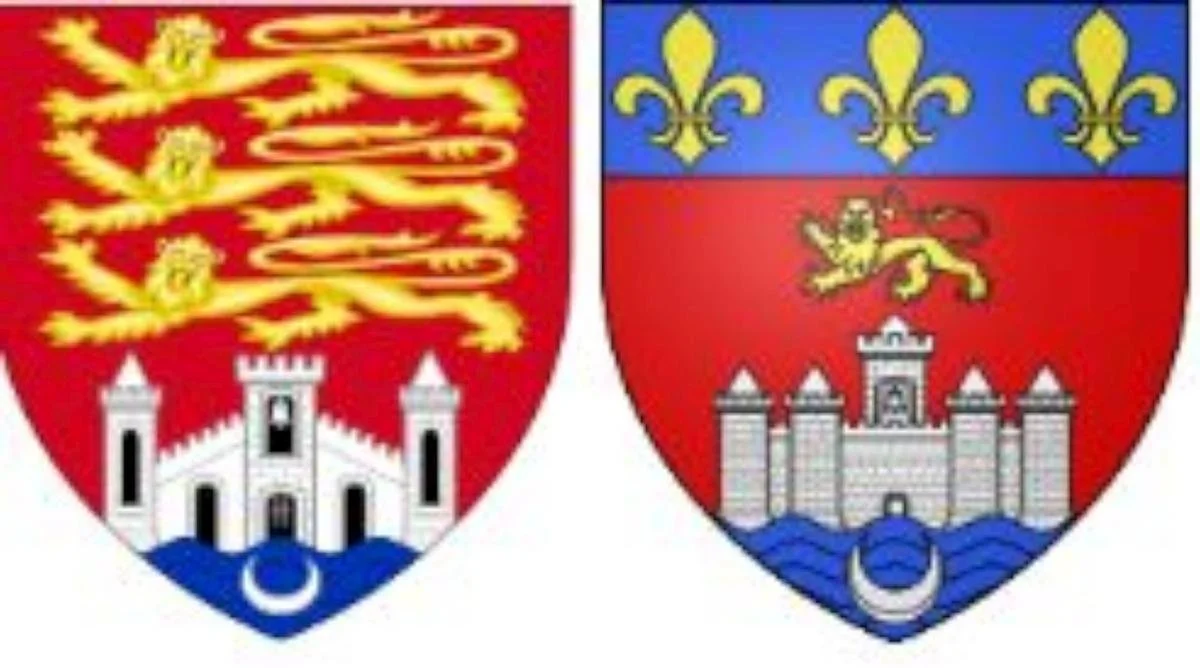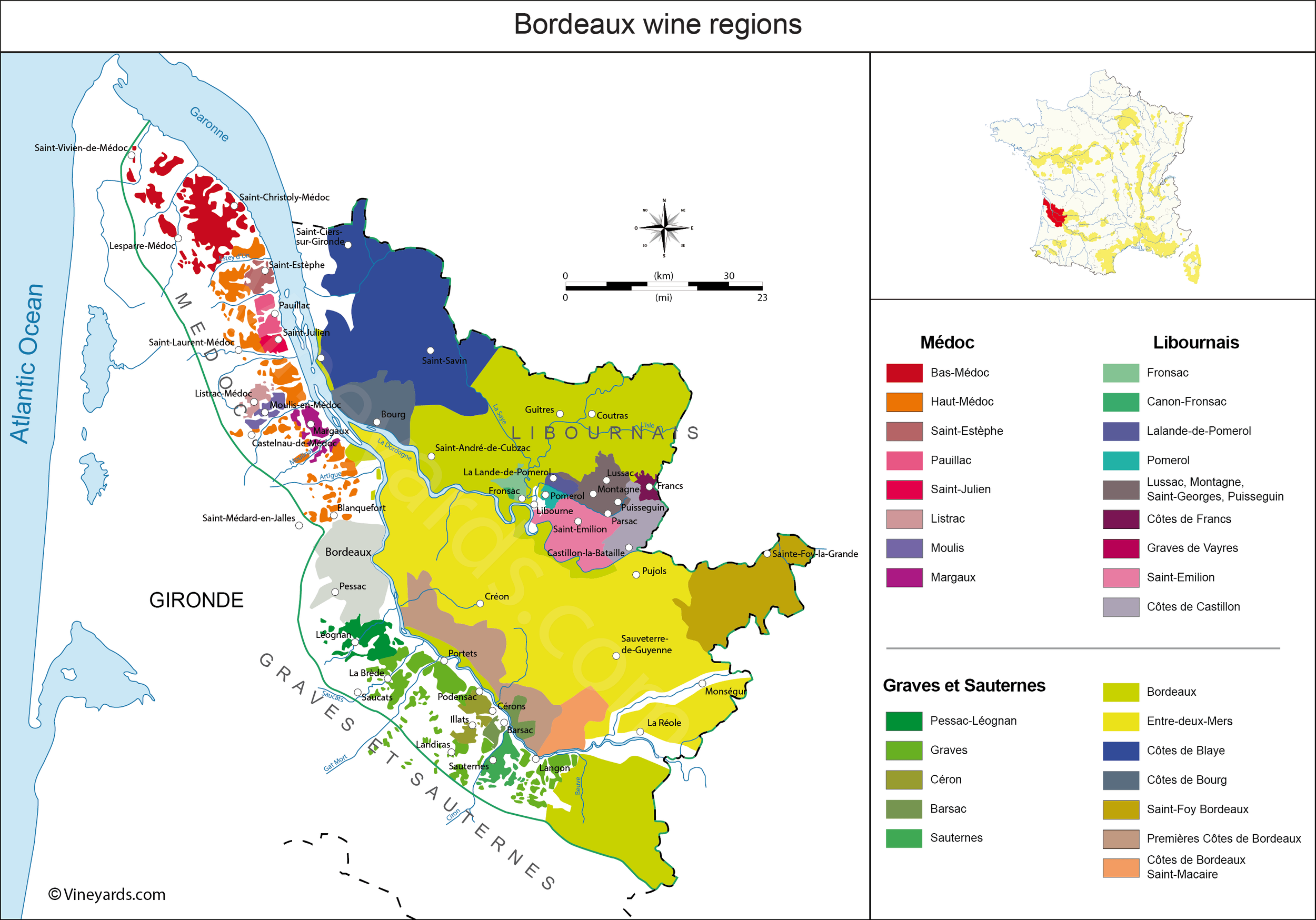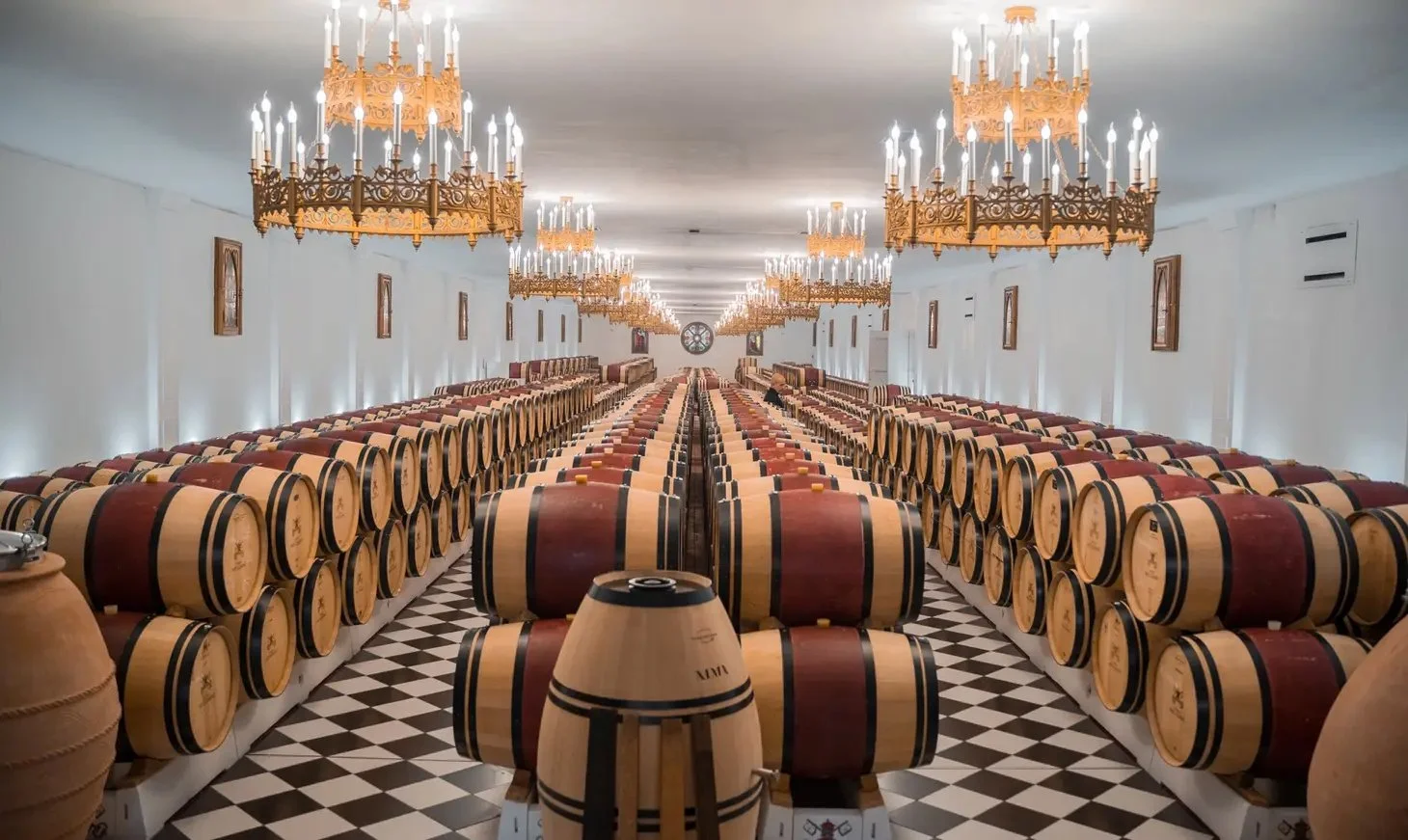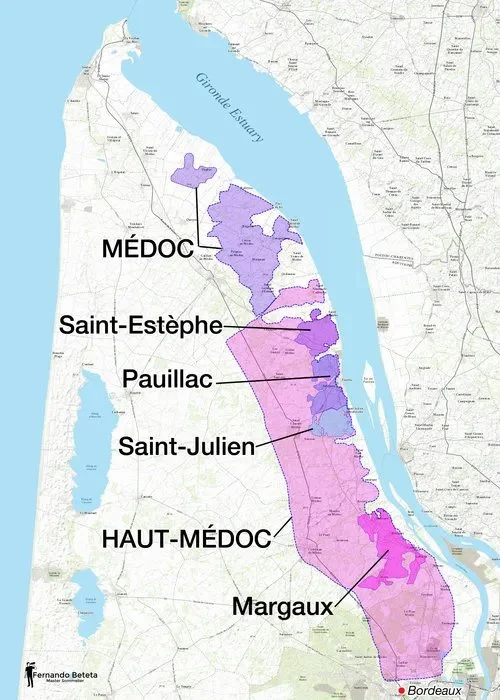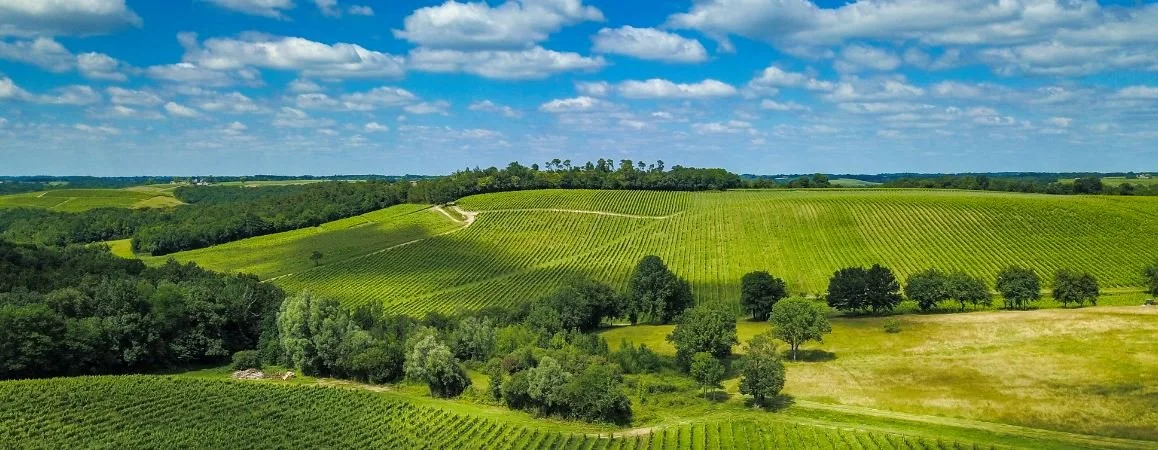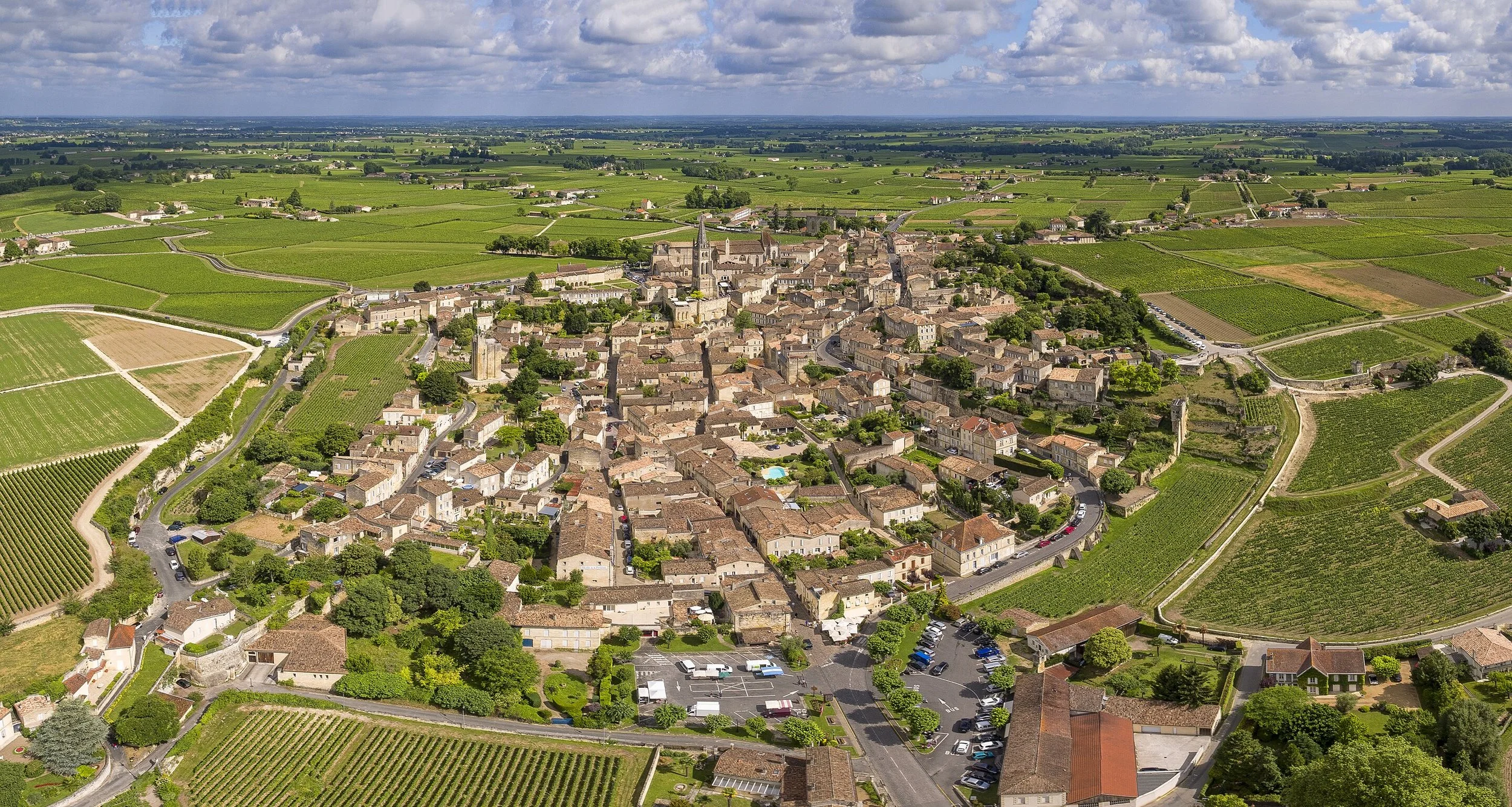The Place de la Bourse & the Water Mirror
Bordeaux- history, wealth and power
Bordeaux was settled in the 6th-5th Century BC by celtic tribes, eventually acquiring the name Burgidalia by about 300 BC. The Romans built a legionary camp and eventually a town there, at the widest point of the river where their engineers could still bridge the river, adopting the Celtic name. The Romans planted the ancient variety Biturica, hardy enough to survive the harsher winters away from the Mediterranean. Biturica plantings were maintained, largely by the Church, through the Roman and Medieval periods. The Roman city became an important entrepot for tin and lead shipped from Cornwall to Rome and a major trading town and port by the late First Century AD. After being sacked by the Vandals in 276 and again in 409, then by the Visigoths in 414 and the Franks in 498, the city with its grand amphitheatre and imperial monuments, fell into a period of obscurity.
The Piliers de Tutele, built under Augustus and razed by Louis XIV, as drawn by Claude Perrault (image credit)
The city became an important political and episcopal seat as the capital of the Frankish Duchy of Vasconia, established to keep control of the Basques to the south, with Vasconia derived from the Frankish pronunciation of Basque. Over time, the name transmuted from Vasconia to Gascony, the name in use today for the region from Bordeaux south to the Pyrennees.
In 732 the city was again sacked and plundered, this time by Umayyad forces under Abd er Rahman, but Duke Eudes of Aquitaine was able to repel the Moors and regain control through the battles of Bordeaux and Poitiers, which marked the high point of Arab incursion into western Europe. In 737 Charles Martel, the Major Domo of a series of weak Merovingian kings, defeated Eudes’ son, conquered Bordeaux and proclaimed himself Duke (of several territories) and Prince of the Franks. The Royal title itself lapsed after the death of the Merovingian King Theuderic IV and no King was named until Martel’s son Pepin assumed the royal title in 751, followed by his own son Charles the Great (Charlemagne) who was named Emperor in 800 AD, 324 years after the last Emperor in the West was deposed in 476.
Bordeaux continued as the capital of Aquitaine and Gascony and a bustling trade center in spite of repeated Viking invasions, and political stability was established under the house of Poitiers until the area fell under English control as a result of Henry II’s marriage to Eleanor of Aquitaine in 1152. This ushered in a three-century period of strong English influence over Bordeaux, which led directly to the English influence over the Bordeaux wine trade in the 16th and 17th Centuries. Bordeaux and Gascony were finally formally annexed to the Kingdom of France only in 1653 with the entry of Louis XIV and his army into the city.
The Porte Cailhau, Bordeaux’s medieval gate, then and now
In the 17th Century, the Dutch, along with the Hanseatic League and the Bretons, became major buyers of Bordeaux wine. They established trading houses in the city, buying the finest wines and shipping them in barrel back to the home countries. The Dutch introduced the technique of sterilizing the barrels with sulfur to protect the quality of the wine during shipment.
The 18th century saw another golden age of Bordeaux. Port de la Lune, The Port of the Moon, Bordeaux’ harbor district, supplied the majority of Europe with coffee, cocoa, sugar, cotton and indigo, becoming France's busiest port and the second busiest port in the world after London. The Dutch, engaging more deeply with the production of fine wines, brought in hydraulic engineers to drain the swamplands of the Medoc, creating one of the worlds most important fine wine regions. This is the period in which Cabernet Sauvignon appears to have evolved, as a natural cross between the longer-planted Cabernet Franc (originating in southern Gascony and later brought north to Saint Emilion, and Sauvignon Blanc (originating in the Loire and later brought south to Bordeaux).
By French Revolution (1789), The Gironde valley’s economic economy was driven by the city of Bordeaux’s trade and commerce; principally the colonial trade with the Caribbean colonies, the slave trade, and the wine trade with northern Europe. The trade in enslaved people was mostly in those headed to France’s colony of Sant-Domingue (currently Haiti). The slave revolt of 1791 in Haiti, “The Pearl of the West Indies” and France’s most profitable overseas colony, led to the colony’s independence from Napoleonic France in 1804, and led to the collapse of the slave trade and with it, the Bordeaux economy.
After the Bourbon Restoration under Louis XVIII in 1814, the economy of Bordeaux was rebuilt by traders and shipowners. They built the first bridge since the Romans over the Gironde, and shipping traffic grew through the new African colonies. The city was transformed under its longtime prefect, Georges-Eugène Haussmann, who widened streets, created broad avenues and plazas and had block after block of handsome stone-facade buildings constructed. Victor Hugo found the rebuilt city so beautiful he said: "Take Versailles, add Antwerp, and you have Bordeaux.” Haussmann later used Bordeaux's large-scale rebuilding as a model when he was asked by Emperor Napoleon III to transform the quasi-medieval Paris into a "modern" capital that would make France proud.
La Porte de La Lune, 1899
In 1870, at the beginning of the Franco-Prussian war against Prussia, the French government temporarily relocated to Bordeaux from Paris. That recurred during World War I and again briefly during World War II, when it became clear that Paris would fall into German hands. Once Bordeaux also fell under German occupation, Italian and then German submarine bases were established in the city’s port. The massive, reinforced concrete U-boat pens have proved impractical to demolish and are now partly used as a cultural center for exhibitions.
Chateau Pichon Baron, Pauillac
today, listed by unesco
In 2007, 40% of the city surface area, located around the Port of the Moon, was listed as a UNESCO World Heritage Site, inscribed as "an inhabited historic city, an outstanding urban and architectural ensemble, created in the age of the Enlightenment, whose values continued up to the first half of the 20th century, with more protected buildings than any other French city except Paris.”
The modern city is a world capital of wine, home to some of the most important global brokers and distributors, as well as a center for research and development. Le Cite du Vin, created by the Foundation for Wine Culture & Civilizations, is a monument to 8,000 years of winemaking history, including the 2,000 years since the Romans introduced the vine to Bordeaux.
Le Cite du Vin in Bordeaux - the world’s preeminent wine museum and education center.
Bordeaux- overall climate & terroir
There are some 8.500 Chateaux (wine estates) in the Bordeaux region, spread out over 5 main subregions- broadly the Right Bank (of the Gironde River) known as the Libournais, the Left Bank (again of the Gironde) known as the Medoc and Graves districts along with Sauternes and its nearby sweet-wine appellations, and the Entre-deux-Mers, the region between the Garonne and Dordogne rivers which join to form the Gironde just above the city of Bordeaux.
climate & terroir
The climate of the city and its environs are classified as humid, subtropical. Cool, wet winters are followed by warm, dry summers with enough rainfall to avoid a “Mediterranean” climate classification. Frosts occur every year, and winter snowfall is not unusual.
The terroir of Bordeaux is variable but is largely underlain by clays, sand and gravel of marine and riverine origin. The variability and regional mesoclimates give rise to the 57 distinct appellations controlees found in bordeaux.
Blasons of the City of Bordeaux. (Left) Richard the Lionheart’s (left) showing the Lion of Wales, the medieval gate and bell tower, and the crescent moon representing the port. (Right) the modern Blason (1913) adding the Fleur de Lys of the King of France.
Grape varieties
Since the 17th Century, this region has been known as the home of Cabernet and Merlot for reds, and Sauvignon Blanc for the whites. In more detail, the reds are made from the “classic five” Bordeaux varieties- the closely-related Cabernet Sauvignon, Cabernet Franc, Merlot, and Petit Verdot, and then the more distant Malbec (Cot). Prior to the advent of phylloxera, Carmenere (also closely related to the Cabernets) was also an important variety in the region, but was extinguished during replanting in the late 1800’s. Recently, as a response to climate change, several hot-climate varieties from Portugal including Touriga Nacional have been authorized for use as up to 5% of the most Basic Bordeaux appellation wines.
“The vines that make Argentina and Chile famous are originally from Bordeaux cuttings. The Bordeaux grapes Merlot and Carmenere took root in Chile and excelled. Malbec is now more famous for its work in Argentina, but is native to Bordeaux. ”
The whites are blends of Sauvignon Blanc, Semillion, Sauvignon Gris, and Muscadelle. Dry wines tend to be rich in Sauvignon Blanc, while sweet whites are based on Semillon, which is susceptible to pourriture noble (noble rot) a fungus that perforates the skins and concentrates the juices by shrivelling the grapes to a raisin-like state.
“Did you know... Cabernet Sauvignon, one of the world’s most important grape varieties, is a genetic cross of Cabernet Franc with Sauvignon Blanc.”
the bordeaux classification system
Bordeaux has 5 classification systems that overlay the appellations controlees. While the AC system delineates terroir by quality and style of the wines produced there, the classification systems work within a given AC to indicate relative quality. The five levels are:
The 1855 Classification (Medoc & Sauternes-Barsac)
The Saine Emilion Classification of 1955
The Graves Classification of 1959
The Cru Bourgeois Classification (updated annually)
The Crus Artisans Classification of 1989, reviewed every 5 years.
The Chateaux of the Medoc were first classified for the Exposition Universelle de Paris in 1855. Of the 6,000 or so Chateaux in the Medoc region, a total of 61 are denoted crus classés (classified growths). These are divided into five categories: 5 Premiers Crus (First Growths), 14 Deuxièmes Crus (Second Growths), 14 Troisièmes Crus (Third Growths), 10 Quatrièmes Crus (Fourth Growths), and 18 Cinquièmes Crus (Fifth Growths). All but one of these châteaux are located in the Médoc region, with Château Haut-Brion in Graves, too great to be left out, being the exception. A significant revision to the system in 1955 elevated Chateau Mouton from Deuxieme to Premier Grand Cru Classe status, creating today’s 5 Premiers Grands Crus out of some 6,000 estates.
Graves: Chateau Pape-Clement’s barrel cellar
Graves, classified in 1959, includes 16 Grands Crus Classes, which of course includes Chateau Haut-Brion making it a Premier Grand Cru of the Medoc and a Grand Cru Classe of Graves.
Sauternes-Barsac, with its 4700 acres, 140 growers and 126 chateaux was classified in 1855 along with the Medoc, dividing the crus into three levels. Premier Cru Superieur (one estate, Chateau d’Yquem), Premier Cru (11 Chateaux) and Deuxieme Cru (15 Chateaux). The AOC Barsac, adjacent to Sauternes, may use either the Sauternes or Barsac designation.
Saint-Emilion, was first classified in 1955, and that classification is revisited about every ten years, most recently in 2022. There are four levels in the St. Emilion classification of its wines, Premier Grand Cru Classe A (2 estates), Premier Grand Cru Classe B (17 estates), Grand Cru Classe (71 estates), and Grand Cru (about 400 estates). The distinction between Saint Emilion Grand Cru Classe and Saint Emilion Grand Cru is important- the Classe designation is a quality distinction regarding the vineyard (or portion of a Chateau’s vineyards), which Saint Emilion Grand Cru is an appellation controllee with exactly the same geographic range as Saint-Emilion. Compared to Saint-Emilion, Saint-Emilion Grand Cru requires lower yields and longer ageing before release, not unlike thee “Superiore” designation within the Italian DOC system. There has been some recent dispute over the way in which vineyards are assigned to the various classes, and as a result, both Chateau Cheval Blanc and Chateau Ausone, formerly Premier Grand Cru Classe A (and the only two until the 2012 reclassificaion), have pulled out of the system leaving just Chateau Angelus and then in 2021 Angelus dropped out, but in 2022 Chateau Figeac was promoted, leaving today Chateau Figeac and Chateau Pavie as Classe A estates.
Pomerol
Pomerol still has no official classification, but of the 150 or so estates in the tiny region’s 1976 acres, Chateau Petrus and Chateau Le Pin are widely regarded as being on a quality par with the first growth wines of the Medoc.
The Cru Bourgeois Classification- a voluntary classification scheme first formalized in 1932. Covers some 250 estates in the Medoc, Haut Medoc or any of the 6 villages in the Medoc with their own appellations controlees.
The Crus Artisans Classification- formalized in 1989, a group of 36 estates with Medoc or higher appellation, where the owner is actively involved in the vineyards and cellar. Recognized under EU regulation since 1994.
the bordeaux regions
the medoc
This region, located along the left bank of the Gironde estuary, was largely swampland until it was drained by Dutch (of course) hydraulic engineers in the 18th Century. It’s name derives from the latin In Medio Aquae - between the waters - reflecting its position pinned between the Gironde and the Atlantic to the west. Soils are more clay rich in northern Bas- (Lower-) medoc, and more gravel-rich and better drained in the more southern Haut- (Upper-) Medoc.
France- the Medoc (courtesy Fernando Beteta)
The Medoc’s four most important villages with their own sub-appellations and Grands Crus vineyards are (north to south) Saint-Estephe, known for its burly, long-ageing wines; Pauillac; recognized for its balanced, poised and ageworthy wines (and 3 of the Medoc’s 4 Premiers Grands Crus); Saint-Julien with its expressive, fruit-driven wines, and finally Margaux, famed for its scented, elegant wines and eponymous Premier Grand Cru vineyard, Chateau Margaux. The villages of Listrac and Moulis also have their own appellations controllees, but no Cru Classe vineyards.
Chateau Margaux
Wines of the Medoc’s warm sandy/gravelly soils tend to be majority Cabernet, and the majority of the Cabernet tends to be Cabernet Sauvignon.
Mouton 1982 (label artwork, John Huston)
Entre-Deux-Mers
This district of rolling hills on largely limestone terroir, laying between the waters of the Dordogne to the north and the Garonne to the south, is largely known for its white wines, blends rich in Sauvignon Blanc with Sauvignon Gris and Muscadelle also grown. The strip facing the Garonne is the appellation Premiers Cotes de Bordeaux and again produces more red wine.
Vineyards in Entre-deux-Mers
the libournais
Saint Emilion credit
Named for the village of Libourne adjacent to both the Saint Emilion and Pomerol appellations (but not, itself, in any Appellation Controllee) The Libournais is a large sweeping district on the right bank fo the Gironde that includes Saint Emilion, Pomerol, the satellite appellations of Lussac, Montagne and Puisseguin-Saint-Emilion, Fronsac and Canon-Fronsac, Cote des Francs, Lalande de Pomerol, and the Cotes de Castillion. Also on the adjacent right bank are the lesser appellations of the Cotes de Bourg and the Cotes de Blaye.
Wines of the Libournais tend to be majority Merlot, which prefers the cooler clay-based soils of the area, and the Cabernet used tends to be rich in Cabernet Franc.
Saint-Emilion, a rolling region of about slightly over 13,000 acres, is named for an 8th-Century hermit named Aemilianus who sought solitude and enlightenment in the area. The vineyard area is dominated by sandy/clayey soils underlain by limestones. This suits it well to both Merlot and Cabernet Franc - Chateau Cheval Blanc, widely regarded as the finest estate in Saint Emilion, is typically 55% Cabernet Franc, 40 Merlot and 5% Cabernet Sauvignon. Saint-Emilion is inscribed as a UNESCO World Heritage Site.
Pomerol, a small plateau of some 2000 acres, is underlain with a thick layer of blue marine clays. These clays define the terroir and the style of the wines, and are the reason why over 80 percent of the appellation is planted to Merlot. The clays reach the surface at the “Petrus buttonhole” a small area centered on Chateau Petrus, which is the world’s finest (and most expensive) 100% Merlot wine.
Graves & sauternes
Chateau Haut Brion, Graves’ most important Chateau, credit
Graves, named for the very gravelly soil of the region, is the original vineyard land of Bordeaux, and includes vineyards within the city limits of Bordeaux itself. It is situated on the left bank of the Dordogne and includes the district of Pessac-Leognan (designated as an appellation controlee in 1987), named for two smaller villages to the south of the city.
Sauternes, Barsac, Cerons, Monbazillac, Loupiac, Cadillac, and Saint Croix du Mont are all appellations south of Bordeaux and along the Dordogne, best known for their sweet wines made from largely Semillon, with subsidiary Sauvignon Blanc and occasionally Muscadelle. The latter three are actually just across the river inside the Premiers Cotes de Bordeaux appellation. The most famous of these great dessert wines is Chateau d’Yquem, a wine prized by Jefferson and Washington for their own cellars. Some parts, like Cerons, make dry red and white wines under the broader Graves appellation.
cotes de bordeaux
Cotes du Bordeaux is a sort of catchall designation for areas that fall outside other nearby AOCs. Created in 2009, it includes five non-contiguous geographical areas: Blaye (opposite the Medoc in the far north of the Libournais), Castillon and Francs (Southeast Libournais), Cadillac (southern fringe Entre-Deux-Mers facing the Dordogne), and Sainte-Foy (far eastern EDM). These areas were previously known as Premières Côtes de Blaye, Premières Côtes de Bordeaux, Côtes de Castillon, Bordeaux Côtes de Francs, and Sainte-Foy Bordeaux.


